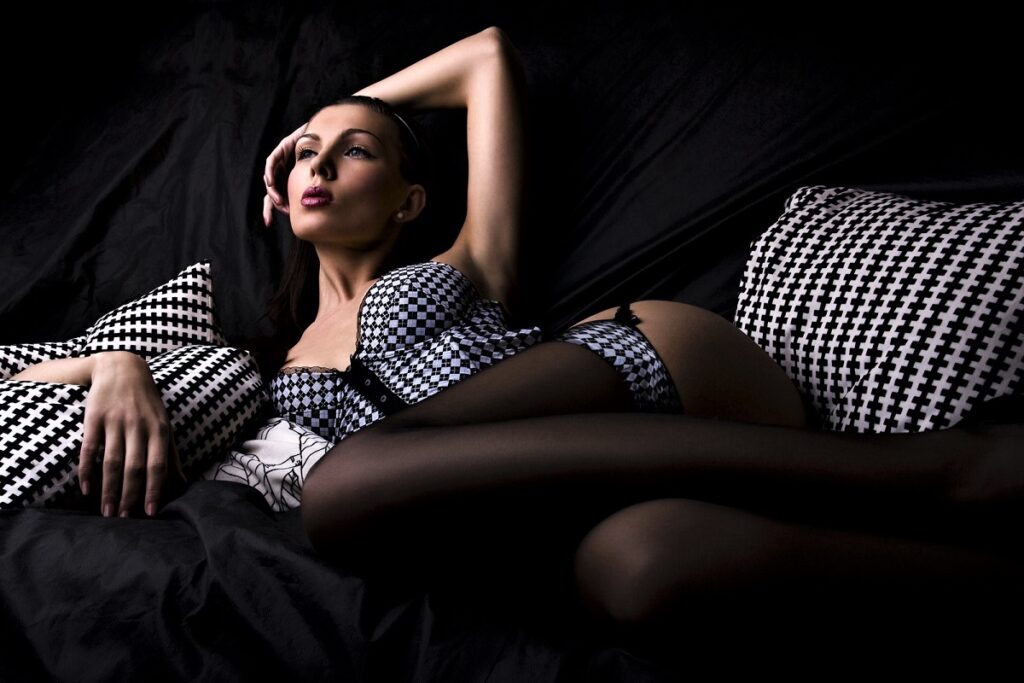They have come to embody such conflicting impulses to exaggerate, deform, inflate, and exalt the female physique that you wonder whether all of it is a bit much.
Over the years, the corset – a garment with a rigid, boned bodice laced tight to shape the torso – has earned a contradictory reputation. Most would say deservedly so.
“After all, what single garment encapsulates the history of women’s dress – of restriction and emancipation – more succinctly than the corset?” says fashion writer Alexander Fury in an article for the New York Times.

Squeezing Sexy into the Body
We find its earliest iteration among the Minoan people in Grecian Crete. Even then, the garment’s intended purpose seemed more erotic than practical.
Much like its early successors, the Minoan corset squeezed the human body into a shape that accentuated the sensuality of its curves, often exposing bare female breasts.
Unlike subsequent cultures, however, the Minoans did not limit this idealized figure to women. Images on ancient pottery show men sporting form-fitting belts and outer vests with metal rings and leather straps to constrict the midriff.
Such was the Minoan fixation on slim waists that parents likewise tightened girdles around their children to stop growth in the abdomen.

Corsets in the Middle Ages
The Middle Ages forced vast cultural transformations throughout Europe.
The fall of the Western Roman Empire catapulted the Catholic clergy into power and with its ascent came new ideas, opinions, and politics.
The body lost its erotic virtues, becoming venal and sinful. Loose, flowing tunics and long clothing became the trend among the fashionably devout – and none of them accentuated curves.
Historians are unsure whether the women of the time wore corsets under their housecoats. There was so much war, looting, and burning going on that few records remain from that pivotal moment in European history.
But the early Christian aversion for the sensual and earthly couldn’t have helped perpetuate the garment’s use.
A 12th century illustration of the devil wearing a corset suggests the garment had somehow devolved into a kind of cultural profanity. So, instead of a separate garment, dressmakers of the time sewed bones or wooden slats into gowns when outer garments required some shape.

Reinventing a Classic
The corset would only begin to shed some of its devilish reputation in the 16th century, when, what started as a close-fitting bodice, evolved into an undergarment.
What we now know as the corset had stays made of whalebone, and then steel. The stays encircled the ribs and compressed the natural waist.
Paintings from the 17th century depict an increasing focus on women’s breasts as an expression of beauty. Many artists painted important people of the era – such as Queen Mary II, Henrietta Maria, and the wife of Charles I of England – with fully bare breasts.
Quite fittingly, so to speak, at a time when fecund female breasts were desired, corsets accentuated them, heaping ample emphasis on the décolletage.

“Lord Preserve the Nation …”
The late 1800s brought a cultural sea change of sorts to Europe, demanding the same oppressive devotion to impeccable appearance on both men and women.
Towards the late 1700s and early 1800s, the most popular look for men included form-fitting trousers and jackets. To achieve this look at the highest standard, some men turned to corsets, risking censure, tarnished reputations, and even jail in the process.
Conservative 19th-century society viewed male corsets with profound distrust, associating its wearers with homosexuality – still a criminal offense in many countries back then.
“The Lord preserve the nation from a generation of male corset wearers,” said one anonymous English observer in 1889.
At the same time, women’s corsets were considered a moral requirement, a compulsory layer of clothing in polite society.

The shape of the corset continued to undergo changes throughout. There were longer styles that covered the hips and shorter versions that emphasized the waistline.
But the corset’s function never wavered. In fact, between the 1800s and 1900s, people began lacing corsets so tightly they sometimes caused women to faint.
The purpose of the tight lacing was not only to highlight the breasts, but also to force the body into desired silhouettes with steel stays.
First there was the hourglass shape popular in the 1800s, and then there was the “S” figure of the following century.
Just how detrimental this heavy-handed shaping was to the human body became clear after doctors blamed it for internal damage, deformities to the rib, and miscarriages!

A Looser, More Liberated Fit
The introduction of elastic in the 1920s mercifully gave rise to flexible sports corsets.
Of course, designers were quick to use the material to attract women who had taken to a new, more politically active lifestyle. Flappers’ smoked in public, were sexually liberated, and wore undergarments more convenient for shorter skirts and vigorous activity.
This new lifestyle called for designs for slimmer, more youthful figures with narrower waists and lower bust lines.
“Corsets no longer constricted the waist, really, but instead they would give you a smooth line, like today’s Spanx for example, and the silhouette was quite slender, needing just one slim petticoat instead of several,” says Alden O’ Brien, curator for costume and textiles in the Daughters of the American Revolution Museum in Washington, DC.
“Dresses were looser-fitting, whereas they used to be very precisely fitted to the corseted figure.”

The Height of Feminist Fashion
With the shift towards sport and healthy lifestyles in the ’60s and ’70s, women abandoned the corset as an everyday undergarment altogether.
But by then, the ideal body it sought to shape was already deeply ensconced in the cultural psyche.
The fashion designer Vivienne Westwood began using corsets in the 70s as part of her distinctive aesthetic, giving rise to the idea corsets empowered women rather than bound them.
Designers like Jean-Paul Gaultier and Thierry Mugler incorporated corsets into their designs in the 80s and 90s, as well. In time, this renewed interest in the garment began to symbolize rebellious feminine sexuality.
In fact, of the countless designs for which Gaultier is remembered, few linger in the memory like his conical-breasted creation for Madonna’s 1990 Blond Ambition Tour.
Today, women wear corsets as sexy lingerie , a fashion statement, or burlesque costume. And while they may no longer be part of the average woman’s everyday wardrobe, the garments have never truly disappeared from fashion.
Ironically, with all its historical baggage, the corset is making a strong comeback in the context of a burgeoning feminist movement.

Yves Saint Laurent, Stella McCartney, and Tom Ford have all used corsets in their designs in the manner of Westwood in the 70s.
In dance clubs and public events, women will layer a corset over garments rather than under them, promoting a fashion statement that aggressively highlights female sexuality.
“The interesting thing about the current revival is that, despite all that history, a woman wearing a corset today is a symbol of empowerment, of sexual freedom, of control,” says Fury.
“She’s the one holding the laces, the one constructing her own femininity.”
What’s your story? To corset or not to corset? Why not share your thoughts with us by reviewing this story.



